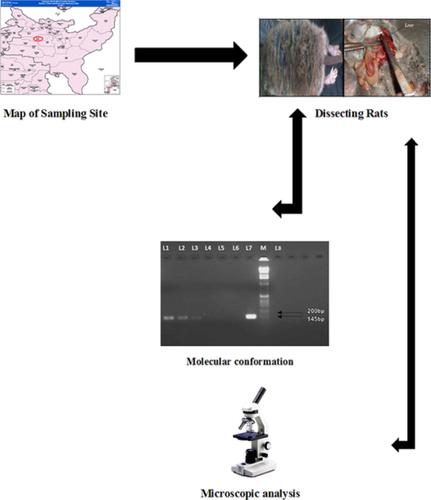当前位置:
X-MOL 学术
›
Microsc. Res. Tech.
›
论文详情
Our official English website, www.x-mol.net, welcomes your
feedback! (Note: you will need to create a separate account there.)
Microscopic and molecular evidence in support of rodent as a reservoir for dissemination of Leishmaniasis.
Microscopy Research and Technique ( IF 2.0 ) Pub Date : 2020-03-06 , DOI: 10.1002/jemt.23462 Imran Khan 1, 2, 3 , Zohaib Noor 1, 3 , Syed Allauddin Khan 4 , Taj Ali Khan 5 , Niaz Muhammad 5 , Bahar Ullah Khattak 5 , Mubashir Hussain 5
Microscopy Research and Technique ( IF 2.0 ) Pub Date : 2020-03-06 , DOI: 10.1002/jemt.23462 Imran Khan 1, 2, 3 , Zohaib Noor 1, 3 , Syed Allauddin Khan 4 , Taj Ali Khan 5 , Niaz Muhammad 5 , Bahar Ullah Khattak 5 , Mubashir Hussain 5
Affiliation

|
Leishmaniasis is a worldwide public health problem and vector‐borne disease. It is caused by a diverse group of protozoan parasites that belong to the genus Leishmania and transmitted to humans through a bite of an infected female sand fly. Leishmaniasis has attained epidemic proportion in Khyber Pakhtunkhwa and raises serious concern over its management. The present research work was conducted in cutaneous leishmaniasis (CL) prevalent village named Surgul of district Kohat, Khyber Pakhtunkhwa with a focus to investigate whether rodent can act as a source for dissemination of leishmanial species or not. In this context, rodent samples were analyzed via morphological and molecular approaches to unveil prevalence of CL. It was reported that 12.5% of samples were positive for signs of leishmaniasis through microscopy and 18.75% through polymerase chain reaction (PCR). Supporting the findings further, the color character of rodents was also taken into consideration, which shows that light dark colored rodents were more infected (13.3%) compared to brown colored rodents (11.43%). Based on our findings, we speculate that small rodents are a possible reservoir of various leishmanial parasites and play a significant role in zoonosis and maintenance of their species.
中文翻译:

显微镜和分子证据支持啮齿动物作为利什曼病的传播库。
利什曼病是世界范围内的公共卫生问题和媒介传播疾病。它是由属于利什曼原虫属的多种原生动物寄生虫引起的并通过叮咬的雌性沙蝇传播给人类。利什曼病已在开伯尔-普赫图赫瓦省流行,并引起了人们对其管理的严重关注。目前的研究工作是在开伯尔-普赫图赫瓦省Kohat区的皮肤利什曼病(CL)流行村庄Surgul中进行的,其重点是调查啮齿动物是否可以作为传播利什曼原虫物种的来源。在这种情况下,通过形态学和分子方法对啮齿动物样品进行了分析,以揭示CL的患病率。据报道,通过显微镜检查,有12.5%的样本显示为利什曼病迹象阳性,而通过聚合酶链反应(PCR),则为18.75%。为了进一步支持该发现,还考虑了啮齿动物的颜色特征,这表明浅色啮齿动物比棕色啮齿动物(11.43%)受到更多的感染(13.3%)。根据我们的发现,我们推测小型啮齿动物可能是各种利什曼原虫的潜在宿主,并且在人畜共患病和维持其物种中起着重要作用。
更新日期:2020-03-06
中文翻译:

显微镜和分子证据支持啮齿动物作为利什曼病的传播库。
利什曼病是世界范围内的公共卫生问题和媒介传播疾病。它是由属于利什曼原虫属的多种原生动物寄生虫引起的并通过叮咬的雌性沙蝇传播给人类。利什曼病已在开伯尔-普赫图赫瓦省流行,并引起了人们对其管理的严重关注。目前的研究工作是在开伯尔-普赫图赫瓦省Kohat区的皮肤利什曼病(CL)流行村庄Surgul中进行的,其重点是调查啮齿动物是否可以作为传播利什曼原虫物种的来源。在这种情况下,通过形态学和分子方法对啮齿动物样品进行了分析,以揭示CL的患病率。据报道,通过显微镜检查,有12.5%的样本显示为利什曼病迹象阳性,而通过聚合酶链反应(PCR),则为18.75%。为了进一步支持该发现,还考虑了啮齿动物的颜色特征,这表明浅色啮齿动物比棕色啮齿动物(11.43%)受到更多的感染(13.3%)。根据我们的发现,我们推测小型啮齿动物可能是各种利什曼原虫的潜在宿主,并且在人畜共患病和维持其物种中起着重要作用。









































 京公网安备 11010802027423号
京公网安备 11010802027423号